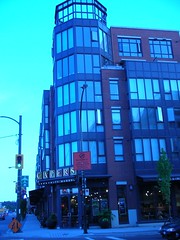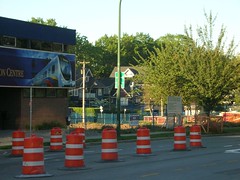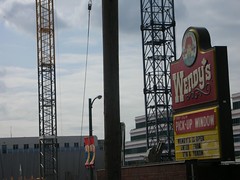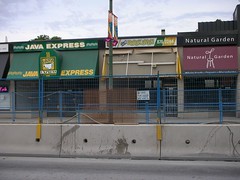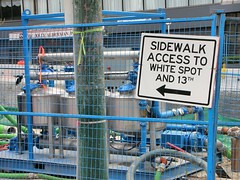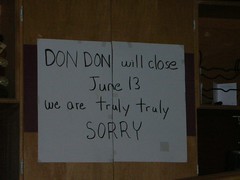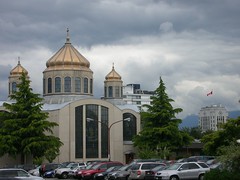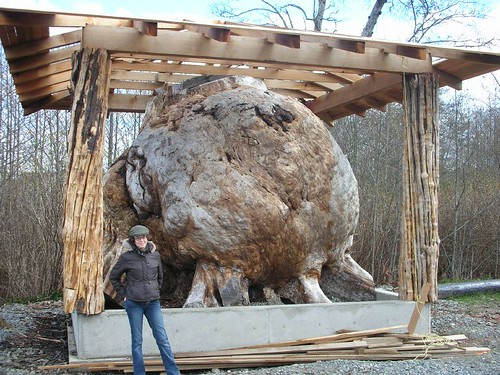Sunday, August 5, 2007
My Paper on the Canada Line/Olympics Connections
This paper mostly explores connections between the Canada Line project as a whole and the 2010 Olympics in the light of this region's courtship of transnational flows of capital and tourists. Some implications for the Cambie Village are also covered, including the "Open for Business" and "I Shop the Line" marketing campaigns that were invented to combat the negative impacts of Canada Line construction.
Happy reading!
Monday, July 30, 2007
Final Thoughts on Cambie
To follow up on the issues explored in the previous few posts about the Cambie Village area's function within Vancouver in the past and present, I raise a few parting questions about the area's potential function in the city.
As higher-density nodes appear around the Canada Line stations and perhaps along the Cambie Village strip as well, Cambie street could eventually function to as a centre of retail, services and culture. It could connect surrounding areas (rather than act as a border between them), drawing people from other parts of the city with an interesting street life. However, Cambie's uncompromised status as a major traffic artery will pose a challenge towards use as a neighbourhood centre in the way that Commercial Drive now functions.
What do you think will define the Cambie Village area in the near future? That future is almost here, but its features remain shadowy for now.
Sunday, July 29, 2007
Trends for the Future
Two years ago, a new multi-story mixed-use retail development went in at the northwest corner of the intersection, featuring a large Capers market on the ground floor, with condos above.
Last month, a swath of single-family homes on the northeast corner (along 16th avenue) were demolished to make room for new condominium construction. This picture, taken on May 30 of this year, shows the corner of the Canada Line Information Centre and the house next door.
This photo, on July 4 shows that the house is gone (along with many of its neighbours along 16th Avenue).
Yes, that is a realtor's sign along the fence. Unbuilt condos are already for sale!
This kind of large-scale redevelopment is not (yet) widespread within the streets surrounding the Cambie Village strip. However, North of Broadway, mixed-use developments which include condos are growing like mushrooms along Cambie Street towards the future "Olympic Village" along False Creek.
Today, standing at Cambie and Broadway and looking across the bridge towards downtown, you see a skyline bristling with cranes. I wonder how far up Cambie the new condo buildings will stretch within a few years. While new development in the Cambie Village area (particularly near the northern end) is ostensibly independent from Canada Line construction, I do think that the pace of change is related to the coming rapid transit line.
<Thursday, July 26, 2007
Will the Canada Line Bring an Economic Boost?
A recent post in the Liveable Region Blog brought to my attention the possibility that the suburban Sheppard Subway line in Toronto faces possible closure closed due to insufficient use. This story ties in rather neatly to the last issue surrounding the Cambie Village and the coming Canada Line that I'd like to explore before wrapping up this blog project: the future of the Cambie Village area.
Do I think the Canada Line will be at risk of closing due to underuse? Not a chance, although I won't be surprised if ridership initially falls below projections, necessitating government support. Rather, the Cambie connection that caught my attention in the blog post about the Sheppard line was this piece of information:
"Although the line was not placed in an ideal location", the new Sheppard line subway "has spurred over $1 billion of construction of new housing, including several high-rise condominium towers along its route."
Politicians such as BC Transportation Minister Kevin Falcon expect that completion of the Canada Line will bring unprecedented prosperity to the Cambie Village area. (This CBC news article explains Mr. Falcon's theory of a coming "economic boost.") Doubtlessly, such a boost would be reflected in rising property values as well as (even more quickly) sprouting condos.
Wouldn't new development be great news for the small businesses along Cambie, as well as for the sense of neighbourhood which is now forming there? Not if change happens too rapidly.
In the long term, changes such as the replacement of many of the old single-story storefronts along Cambie with new multi-level mixed-use developments are bound to occur and would be beneficial in terms of increased density and utility. However, Vancouver's ever-inflating real estate bubble and a municipal policy of densification means that these kinds of changes happen at astonishing speed. Rising costs alienate long-standing local businesses and residents.
Many business tenants who are now currently surviving Canada Line construction fear that they will ultimately be driven out of the area if rising property values translate into inflated rents that only high-turnover chain stores can pay. Others fear eviction if the aging shop buildings they occupy are torn down and replaced with gleaming new mixed-use developments. (Similar concerns are expressed by the owner of the Vintage Violins music shop in this Vancouver Sun article.) The empty shops now in the area can't be helping the area's stability.
The construction boom surrounding even Toronto's ill-advised, underused suburban Sheppard subway line suggests that rising land values are likely to bring rapid changes to the available types of housing surrounding the Cambie Village area as well. As older single-family homes and duplexes are razed to make way for more condominiums, higher densities will be achieved, but affordability in the area is no more likely to improve for residents than for businesses.
Tuesday, July 24, 2007
The Cambie Village a present-day boundary zone? (Part II: East and West)
 Residents of East Van, or "The Republic of East Vancouver," might argue that their district boasts the most vital and tolerant communities, while many a condo ad emphasizes a "West Side" location, or even "West Side School Catchments area". In either case, local allegiances are defined along an east-west divide. This distinction dates back more than a century to the days when the CPR owned most of the land in western Vancouver. CPR land was subdivided into larger, more neatly organized, was sold to the wealthy.
Residents of East Van, or "The Republic of East Vancouver," might argue that their district boasts the most vital and tolerant communities, while many a condo ad emphasizes a "West Side" location, or even "West Side School Catchments area". In either case, local allegiances are defined along an east-west divide. This distinction dates back more than a century to the days when the CPR owned most of the land in western Vancouver. CPR land was subdivided into larger, more neatly organized, was sold to the wealthy. Vancouver's avenue names change from "west" to "east" one block west of Main street, or four blocks east of Cambie. Of the four neighbourhoods that connect in the Cambie Village area, two (Mount Pleasant and Riley Park) extend into East Vancouver. Cambie Village businesses serve both the east and west sectors of the city.
Canada Line construction certainly did not cause Vancouver's long-standing east-west rift, but in the opinion of one East Vancouver-based blogger, construction's toll on the area means that, "in becoming a victim street, labouring beneath conditions imposed upon it from wealthier parts of town.... Cambie... may now unofficially be considered part of East Van -- the part of town that has things... dumped on it, not the part that does the dumping".
As construction grinds on, "Cambie Canyon" acts more like a functional border between East and West Vancouver and less like a zone of connection. The invisible boundary dividing East Vancouver from the more politically powerful west side could be drawn along Cambie street.
In a Vancouver Sun article published this May, journalist Frances Bula points out that ongoing construction along Cambie street interrupts the city's daily functioning, tearing the urban fabric into east and west segments. Disruptions to regular intra-urban flows along Cambie's north-south axis bisect the cityscape nearly in two and create a "physical and psychological east-west barrier," for example making it difficult for children who live on one side of Cambie to get to their schools on the other side. She half-seriously compares the rift to the Berlin Wall, likening overburdened single-lane intersections to West-East checkpoints.
An official Canada Line map (above) shows the extent to which the Canada Line geographically bisects the city.
Much has been made in local media of a rapid-rail project in Seattle which is similar in scope to the Canada Line. Unlike the Canada Line, the Seattle project includes dedicated community development funds in its budget (from the federal government) for supporting local business during the difficult construction period. The Executive Director of the [Seattle] Rainier Valley Community Development Fund recently visited the Cambie Village and, like Francis Bula in the Vancouver Sun article noted above, compared Canada Line construction to the Berlin Wall. I suspect this is not the kind of international attention that the Canada Line funders intend to seek!
The Cambie Village a present-day boundary zone? (Part I: Neighbourhoods)
Nestled right in the middle of present-day Vancouver, The Cambie Village area no longer forms any municipal boundary. However, as Canada Line construction continues, the area functions more like a boundary zone than its central location might suggest.
The Cambie Village area has defined the edges of surrounding neighbourhoods since long before Canada Line construction began. When the City of Vancouver moved its planning focus towards neighbourhood planning in the 1970's, planners identified functioning neighbourhoods and defined unique "neighbourhood plans" in cooperation with local residents. CityPlan, a Vancouver-wide planning framework, concludes that Vancouver is made up of diverse neighbourhoods: "villages within a city, each with its own identity". Where three municipalities once met at the intersection of 16th avenue and Cambie, no less than four officially-defined Vancouver neighbourhoods now connect. These are Mount Pleasant, Fairview, South Cambie and Riley Park/Little Mountain, each with its own neighbourhood plan. I wonder why the Cambie Village area seemed to be the best border when these neighbourhood boundaries were set, presumably in the 1970's. As a major six-lane auto route, did Cambie Street lack cohesiveness or vitality? Did it serve more dispersed areas of residences and offices than, say, Main St, or Arbutus St? Perhaps the neighbourhood boundaries were simply chosen for historic reasons.
Awareness of the Cambie Village area as a functioning urban unit may be very recent indeed. Definition of its boundaries is the subject of polite disagreement. The City of Vancouver's "Cambie Street Improvements" plan places the Northern boundary at City Hall, defining the Cambie Village's extent from 12th avenue to 25th Avenue. On the other hand, the Cambie Village Business Improvement Association defines the area as extending another ten blocks north to 2nd Avenue. This latter view includes the Canada Line stations at Olympic Village (2nd Avenue), Broadway (9th Avenue) and King Edward (25th Avenue). The latter definition emphasizes what the area stands to gain from the future Canada Line.
I haven't been able to find any use of the name "Cambie Village" before Canada Line construction began and the Cambie Village Business Improvement Association was created in 2006. Nor, as far as I know, was there a planning effort to develop a cohesive built environment along the strip before the recent Cambie Village Streetscape Plan. A great deal of community consciousness has arisen in the Cambie Village over the last two years, born of hardship related to construction.
Monday, July 16, 2007
Historic City Boundaries along Cambie
Until 1929, Cambie Street marked the City of Vancouver’s western boundary. Further west lay the municipalities of Point Grey (north of 16th avenue) and South Vancouver (south of 16th avenue). When the current site at 12th avenue and Cambie was chosen in the early 1930’s for Vancouver’s City Hall, protesters opposed its remoteness from the contemporary central city area.
Mayor Gerry McGeer chose the far-flung site for a far-sighted reason - to symbolically and functionally knit the former municipalities of Point Grey and South Vancouver into the central city’s fabric. The municipal boundaries had actually met at 16th avenue, but a mere four blocks does not interfere with good imagery. The city already owned a site at 12th avenue, a nice parcel of land with good views and room to accommodate elegant landscaping. The building of City Hall was completed there in 1936.
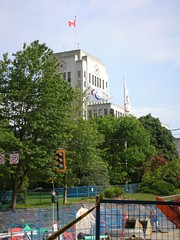
In short order, Mayor McGeer’s far-sighted plan for sewing together the urban patchwork that met at 16th and Cambie seems to have been a success. As reported in the “History of Metropolitan Vancouver” website, the building of City Hall “spark[ed] an extension of the Cambie streetcar line and that, in turn, would spur development of the area.”
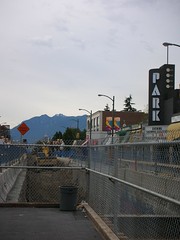
If the extention of a streetcar line down Cambie lead to development of the Cambie Village commercial strip seventy years ago (the landmark Park Theatre dates from around this time), then what might be the effects of the Canada Line on the area once it is completed? History suggests the changes could be dramatic.
Tuesday, July 3, 2007
Replacing the Cambie Village Streetscape
Like the “RAVing about Cambie” video linked to in the previous post, most of the media buzz about the Cambie Village has focused on construction-related traffic upheaval and the hardships faced by local businesses. For municipal planners, however, the grumble of Cambie St. construction represents the knocking of opportunity.
Once built, cities are durable, inflexible things. As critics of the Canada Line project can attest, retrofitting an urban landscape is an involved process, slow and expensive. For one thing, much of the existing streetscape had to be dismantled in order for Canada Line construction to proceed. Once the construction is complete, InTransitBC is officially responsible for putting all those lampposts, trash cans, and lengths of sidewalk back exactly the way they were before all this began.
Instead, the City of Vancouver will jump at the opportunity to upgrade the area’s amenities. Municipal planners have accelerated preparation of a Cambie Village Streetscape Plan to coincide with restoration of the streetscape following construction. In a series of open houses held this spring, planners and local users of the street met to discuss issues such as the best style of street furniture, types of trees, location for bus bulges, and how to delineate the residential from the commercial sections of the Cambie Village. As a neighbourhood resident attending an open house, I was excited to imagine a brighter future for this street and its immediate neighbourhood.
The open house was held in one of several empty storefronts on Cambie. Outside, the dust and noise of ongoing construction was in full swing. Inside, residents and business people considered the prospect of new trees and elegant landscaping along the street, benches to sit on and observe lively street activity, and (finally!) abundant bicycle racks. Mention of the new streetscape’s suitability to accommodate periodic street festivals or farmers’ markets really surprised me. I had never even considered the Cambie Village to be the kind of area that could host those kinds of events. For the last two years, preparations for the Canada Line have dominated the street. Prior to that, I’m not sure that enough community cohesion existed to foster a street festival. If it did exist, it was certainly less visible than today.
And now? I’m very curious to see the unfolding and implementation of this streetscape plan. The timing outlined on the initial public process plan indicates “late spring 2007”, but a look at Cambie Street today suggests a later completion date! I do hope that after Cambie street is finally put back together, local spirits will run high enough to host a street celebration. It would be good to see people sitting on those new benches and enjoying themselves.
Saturday, June 30, 2007
RAVing About Cambie Street
24 Hrs has produced a video podcast about Cambie St construction. If you haven't experienced the chaos first-hand, it's an amusing introduction.
Thursday, June 14, 2007
Accessibility and Urban Form, Part II
A business located at 17th and Cambie such as Jack hair salon will be an 8-block walk from either station. Neil Barkey, the owner of Jack, was doubtful that his business will ever feel much positive impact from the Canada Line. He predicted that the end of construction would see many Cambie Village businesses struggling to recover from debts incurred during this downturn.
An underground rapid transit line is quite different from a streetcar or trolley bus line in the way it brings people to a neighbourhood. Passengers on a trolley bus can disembark at any block, and can view destinations along the route as they travel. On the other hand, an underground railway provides increased accessibility to specific nodes where stations are located.
Neil Barkey hopes that the saving grace for his business will be the estimated 40% of his client base who are local residents. They are regular customers who know their way around today's changing construction, and who will likely remain loyal to their favourite neighbourhood businesses in the future.
Accessibility and Urban Form, Part I
Since the CPR's first passenger train arrived in the new city of Vancouver in 1887, transportation projects both grand and mundane have shaped this city. Logically enough, land value tends to increase as real estate becomes more accessible. When electric streetcar lines radiated out from Vancouver's central city into suburbs like Mount Pleasant and Point Grey, densification of land use along the lines followed, forming "commercial ribbons". Walter Hardwick's 1974 book "Vancouver" shows a photo from 1909 of the 4th Avenue streetcar's first run through Point Grey. Streetcar tracks run down a rough road cut through the trees. The only other visible signs of development are overhead wires and streetlights. What are now Vancouver's central neighbourhoods were initially opened up to development by streetcars.*
Here we go again in the 21st century. As the Canada line improves accessibility between downtown Vancouver, central Richmond and the airport, the built landscape as well as the character of neighbourhoods will be affected along the line. One result is bound to be overall increased density. So far construction has reduced access to areas like the Cambie Village on a temporary basis while land values may already be undergoing anticipatory inflation based on future accessibility.
*If you've ever wondered, the little jog in the commercial strip where Broadway meets Alma St. exists because two streetcar lines (Broadway and 4th Ave) once met there before the tracks followed 10th avenue further west.
Tuesday, June 12, 2007
Online RAV Line Resources
It's interesting to compare the differences in perspective between the more offical sites such as the official Canada Line website and the community groups and blogs.
If I've missed any essential links, please let me know.
Saturday, June 2, 2007
Goodbye Tomato
I had been wondering if the Tomato Cafe's big tomato sign would remain presiding over its corner after the restaurant moved on. Today I walked by and saw that the giant tomato had indeed come down. The building looks totally different without it. A banner informs that a new restaurant will soon try its luck there.
As you can see from the sidewalk art, the tomato will be missed.
The corner of 17th and Cambie looks quite different without the tomato sign:
Before: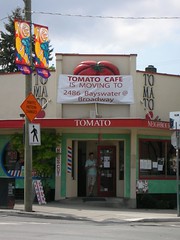
After:
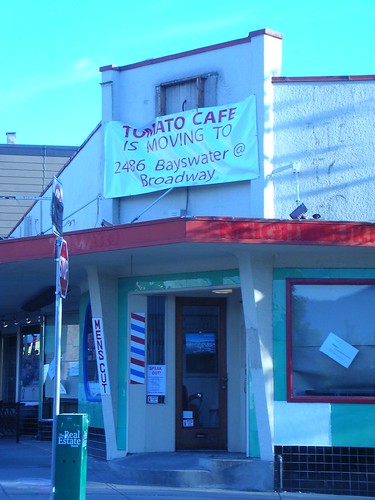
Thursday, May 31, 2007
Art party on Cambie!
Lately it seems that Cambie St has been garnering a lot of attention in local alternative media. The new zine Tooth and Dagger ran a story about the Tomato Cafe's recent departure from Cambie St, and Fairview MP Gregor Robertson’s bill to refund property taxes to the owners of small businesses along Cambie. Yesterday, the “crowd powered” news site nowpublic used some of my Cambie St. photos for an article called “The Village a Train Ate”. The article features an interview with the owners of the Don-Don Noodle Café, who have been forced by a 40 % reduction in revenues to close their shop permanently.
After reading the second article, my mood was woeful. This is the first I had heard of my pending deprivation from the Don Don Noodle House’s wonderful yakisoba and dumplings. In addition to being economic entities, small businesses play a vital role in sustaining the cultural heart of their community. Many shops and restaurants are part community centre; they provide a gathering place for locals and an identity for the district. It was on the bulletin board of the Don Don Noodle House some months ago that I first found out about the campaign to restore trolley bus service on Cambie, for example. There are Starbucks in every district of Vancouver, but only Cambie had a Don Don Noodle House. I remember a conversation with the owner Simon Kim in the summer of 2005, when everyone on Cambie was beginning to realize the extent of the coming chaos. At that time, he had just signed a five-year lease on his restaurant space before learning that the construction would be cut-and-cover. If he had known of the impending disruption, he said, he would have moved his business to a new location.
Economy and culture are two theoretical perspectives from which this blog will examine the changing faces of Cambie St, drawing on the experiences of people who live and work in the neighbourhood. As the two articles referenced above show, the economic picture for many on Cambie St. is presently bleak. The odds are high that before the worst is over, more small businesses will go under. This period of hardship seems to increase the determination of some citizens and business owners to get through the disruption and uncertainty. As the photo at the start of this entry shows, a community member has organized a community art event right on the street, at an intersection where a large paved area remains sandwiched between construction zones. Local businesses such as Hazel & Co and Choices are helping to spread the word by advertising the event in their shop windows. Unfortunately, I’ll be out of town for this week’s outdoor art party, but I hope it is a raging success.
Friday, May 25, 2007
My view of Cambie St.
For a local resident traveling on foot, however, much of the neighbourhood is still surprisingly accessible. My partner and I live along Cambie a few blocks from Vancouver’s City Hall. We venture out regularly to buy groceries, visit neighbours, see movies at the Park Theatre and walk to the Mount Pleasant community centre. After a few months of construction, we are experts on where it's still possible to cross the street and the most efficient routes around construction to visit our favourite shops.
Because of where I live, this blog will present a street-level view of the changing Cambie Village in addition to inquiries about policy, planning and community. The Cambie Village comprises the commercial area along Cambie St. just south of downtown, roughly from Broadway to 25th Ave. The built landscape here has experienced changes accompanying RAV line construction with dramatic economic consequences. Some of the changes to the streetscape are permanent; two sizable properties, a strip mall and an older apartment block were torn down to make way for two future RAV line stations at Broadway and King Edward. The face of local business on Cambie has gotten progressively leaner as pedestrian and vehicle traffic has dried up; over 30 shops have closed their doors, and many more are struggling.
Eventually, construction will end and the 30 storefronts that are now empty will be filled again. What kinds of businesses will fill them? Who will be the residents who will shop there? Will they live in new condo development like the flats over the new Capers' building, or in the older rental housing that is still available in the neighbourhood? Will the rapid transit line bring crime, gentrification or both? Will the shared experience of rapid change and economic adversity lead to a stronger sense of community?
This blog is an assignment for an Urban Geography class. It will span UBC’s summer semester, from May to August, 2007. As the questions above indicate, the fate of the Cambie Village and the surrounding residential area that it serves will remain undecided for much longer than that. However I do believe that the summer 2007 will be a pivotal time for shaping the future of the Cambie Village.
Your comments and discussion are heartily welcome.

